FORD F650 2015 13.G Owner's Manual
Manufacturer: FORD, Model Year: 2015, Model line: F650, Model: FORD F650 2015 13.GPages: 384, PDF Size: 4.95 MB
Page 21 of 384
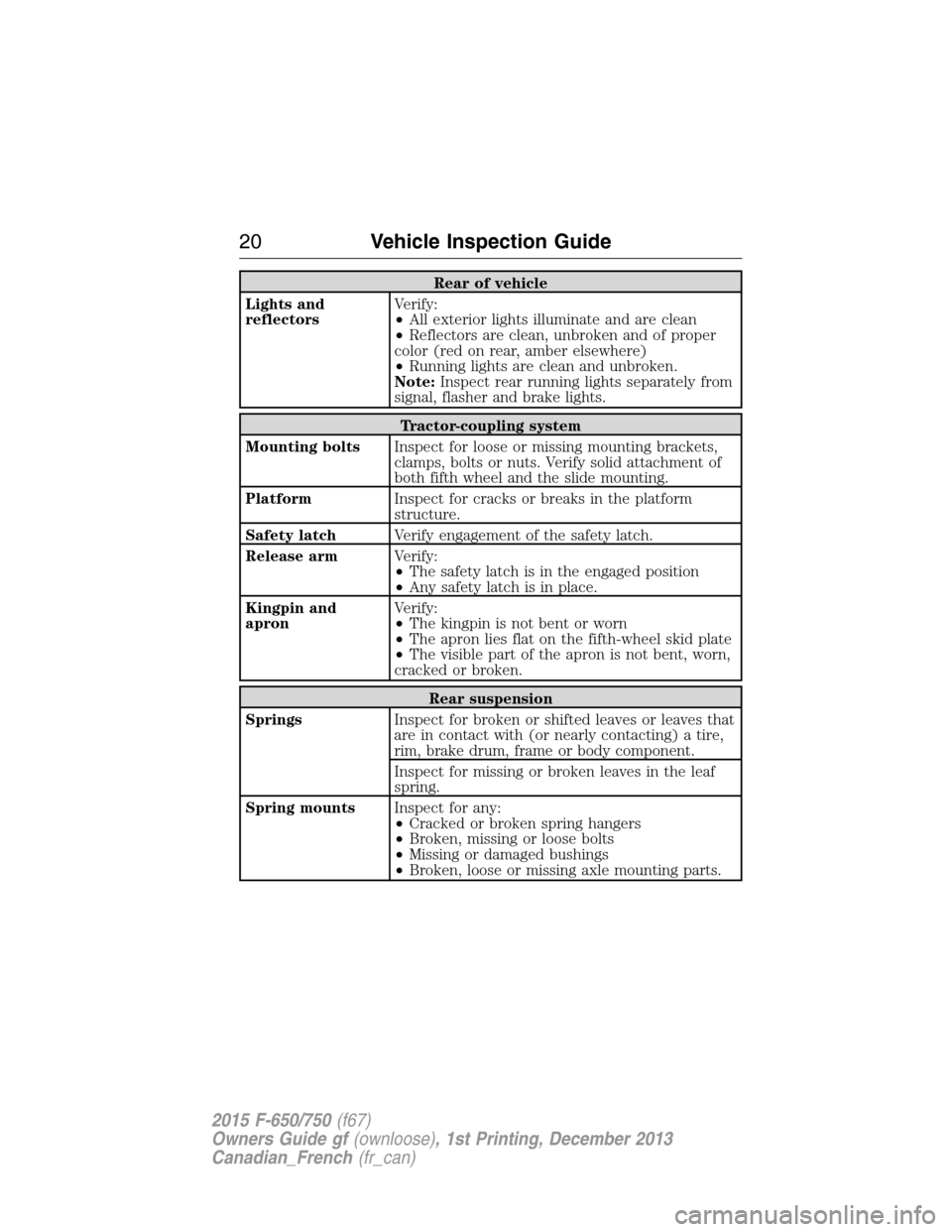
Rear of vehicle
Lights and
reflectorsVerify:
•All exterior lights illuminate and are clean
•Reflectors are clean, unbroken and of proper
color (red on rear, amber elsewhere)
•Running lights are clean and unbroken.
Note:Inspect rear running lights separately from
signal, flasher and brake lights.
Tractor-coupling system
Mounting boltsInspect for loose or missing mounting brackets,
clamps, bolts or nuts. Verify solid attachment of
both fifth wheel and the slide mounting.
PlatformInspect for cracks or breaks in the platform
structure.
Safety latchVerify engagement of the safety latch.
Release armVerify:
•The safety latch is in the engaged position
•Any safety latch is in place.
Kingpin and
apronVerify:
•The kingpin is not bent or worn
•The apron lies flat on the fifth-wheel skid plate
•The visible part of the apron is not bent, worn,
cracked or broken.
Rear suspension
SpringsInspect for broken or shifted leaves or leaves that
are in contact with (or nearly contacting) a tire,
rim, brake drum, frame or body component.
Inspect for missing or broken leaves in the leaf
spring.
Spring mountsInspect for any:
•Cracked or broken spring hangers
•Broken, missing or loose bolts
•Missing or damaged bushings
•Broken, loose or missing axle mounting parts.
20Vehicle Inspection Guide
2015 F-650/750(f67)
Owners Guide gf(ownloose), 1st Printing, December 2013
Canadian_French(fr_can)
Page 22 of 384
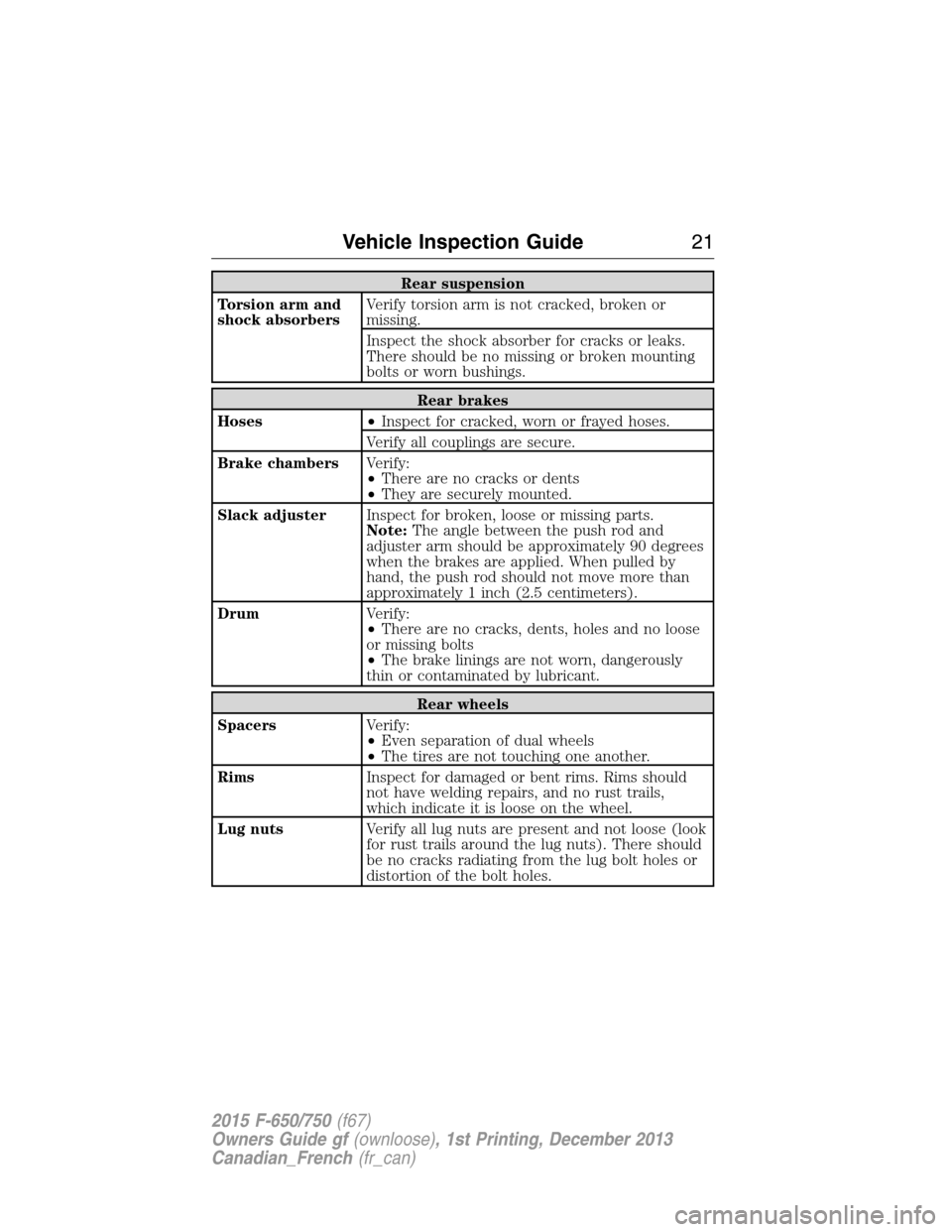
Rear suspension
Torsion arm and
shock absorbersVerify torsion arm is not cracked, broken or
missing.
Inspect the shock absorber for cracks or leaks.
There should be no missing or broken mounting
bolts or worn bushings.
Rear brakes
Hoses•Inspect for cracked, worn or frayed hoses.
Verify all couplings are secure.
Brake chambersVerify:
•There are no cracks or dents
•They are securely mounted.
Slack adjusterInspect for broken, loose or missing parts.
Note:The angle between the push rod and
adjuster arm should be approximately 90 degrees
when the brakes are applied. When pulled by
hand, the push rod should not move more than
approximately 1 inch (2.5 centimeters).
DrumVerify:
•There are no cracks, dents, holes and no loose
or missing bolts
•The brake linings are not worn, dangerously
thin or contaminated by lubricant.
Rear wheels
SpacersVerify:
•Even separation of dual wheels
•The tires are not touching one another.
RimsInspect for damaged or bent rims. Rims should
not have welding repairs, and no rust trails,
which indicate it is loose on the wheel.
Lug nutsVerify all lug nuts are present and not loose (look
for rust trails around the lug nuts). There should
be no cracks radiating from the lug bolt holes or
distortion of the bolt holes.
Vehicle Inspection Guide21
2015 F-650/750(f67)
Owners Guide gf(ownloose), 1st Printing, December 2013
Canadian_French(fr_can)
Page 23 of 384
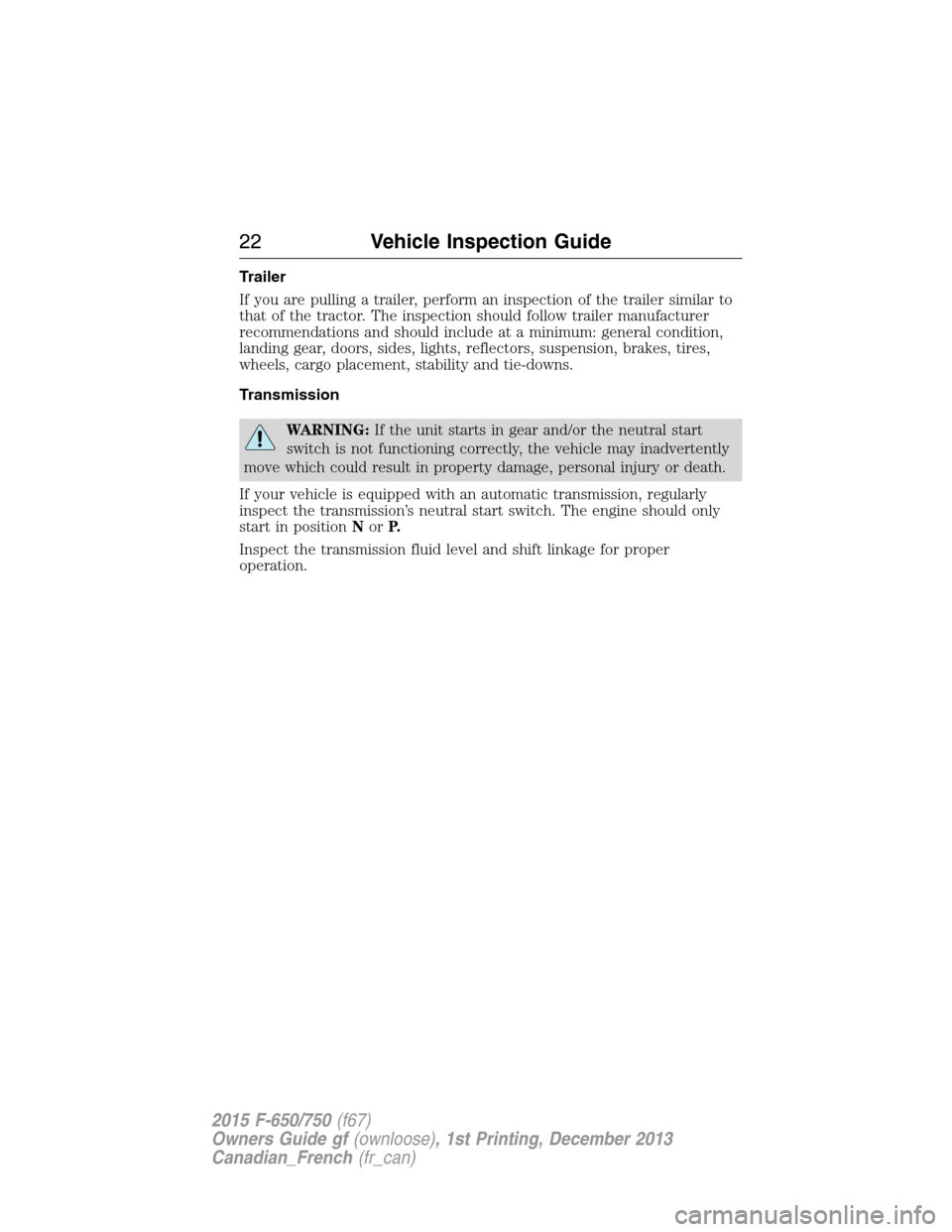
Trailer
If you are pulling a trailer, perform an inspection of the trailer similar to
that of the tractor. The inspection should follow trailer manufacturer
recommendations and should include at a minimum: general condition,
landing gear, doors, sides, lights, reflectors, suspension, brakes, tires,
wheels, cargo placement, stability and tie-downs.
Transmission
WARNING:If the unit starts in gear and/or the neutral start
switch is not functioning correctly, the vehicle may inadvertently
move which could result in property damage, personal injury or death.
If your vehicle is equipped with an automatic transmission, regularly
inspect the transmission’s neutral start switch. The engine should only
start in positionNorP.
Inspect the transmission fluid level and shift linkage for proper
operation.
22Vehicle Inspection Guide
2015 F-650/750(f67)
Owners Guide gf(ownloose), 1st Printing, December 2013
Canadian_French(fr_can)
Page 24 of 384
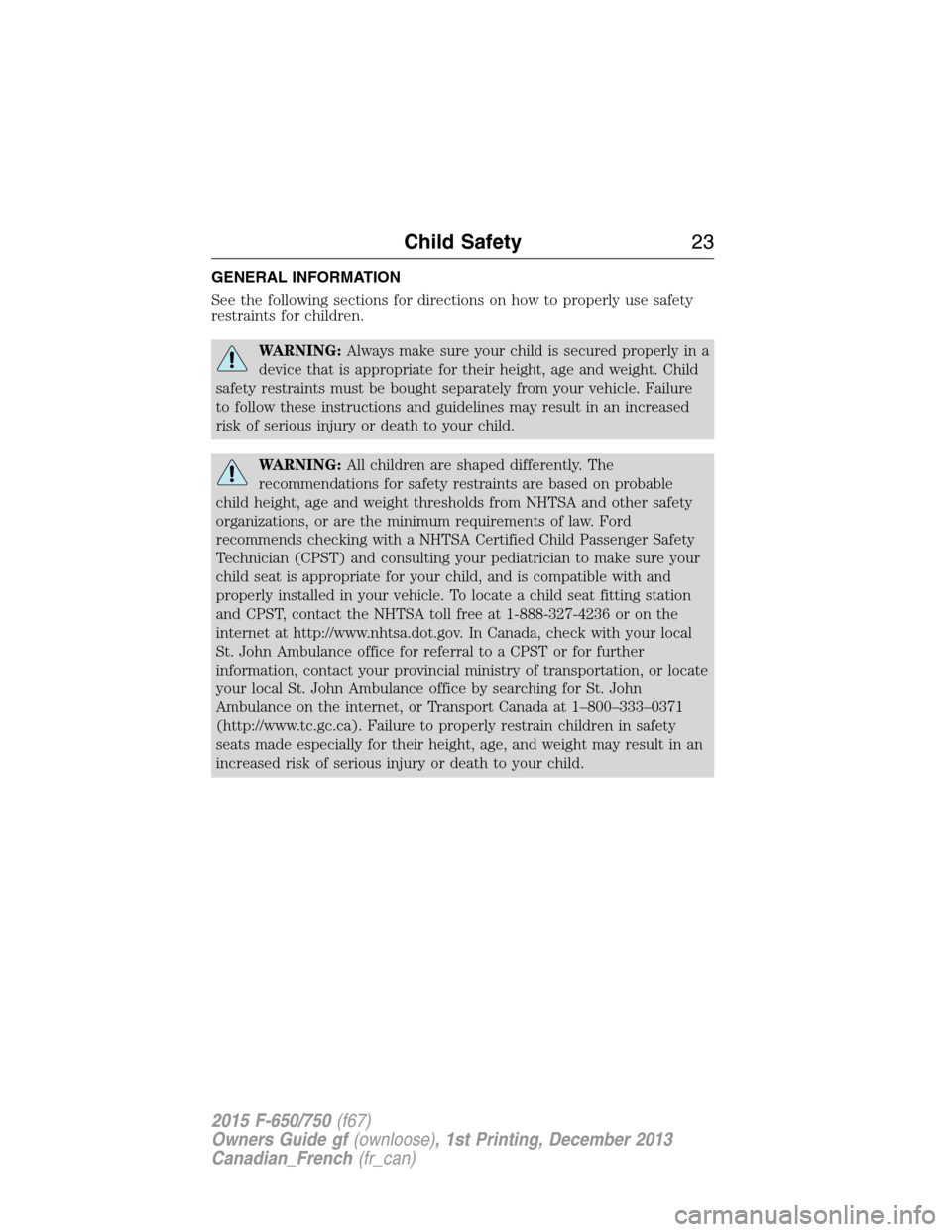
GENERAL INFORMATION
See the following sections for directions on how to properly use safety
restraints for children.
WARNING:Always make sure your child is secured properly in a
device that is appropriate for their height, age and weight. Child
safety restraints must be bought separately from your vehicle. Failure
to follow these instructions and guidelines may result in an increased
risk of serious injury or death to your child.
WARNING:All children are shaped differently. The
recommendations for safety restraints are based on probable
child height, age and weight thresholds from NHTSA and other safety
organizations, or are the minimum requirements of law. Ford
recommends checking with a NHTSA Certified Child Passenger Safety
Technician (CPST) and consulting your pediatrician to make sure your
child seat is appropriate for your child, and is compatible with and
properly installed in your vehicle. To locate a child seat fitting station
and CPST, contact the NHTSA toll free at 1-888-327-4236 or on the
internet at http://www.nhtsa.dot.gov. In Canada, check with your local
St. John Ambulance office for referral to a CPST or for further
information, contact your provincial ministry of transportation, or locate
your local St. John Ambulance office by searching for St. John
Ambulance on the internet, or Transport Canada at 1–800–333–0371
(http://www.tc.gc.ca). Failure to properly restrain children in safety
seats made especially for their height, age, and weight may result in an
increased risk of serious injury or death to your child.
Child Safety23
2015 F-650/750(f67)
Owners Guide gf(ownloose), 1st Printing, December 2013
Canadian_French(fr_can)
Page 25 of 384
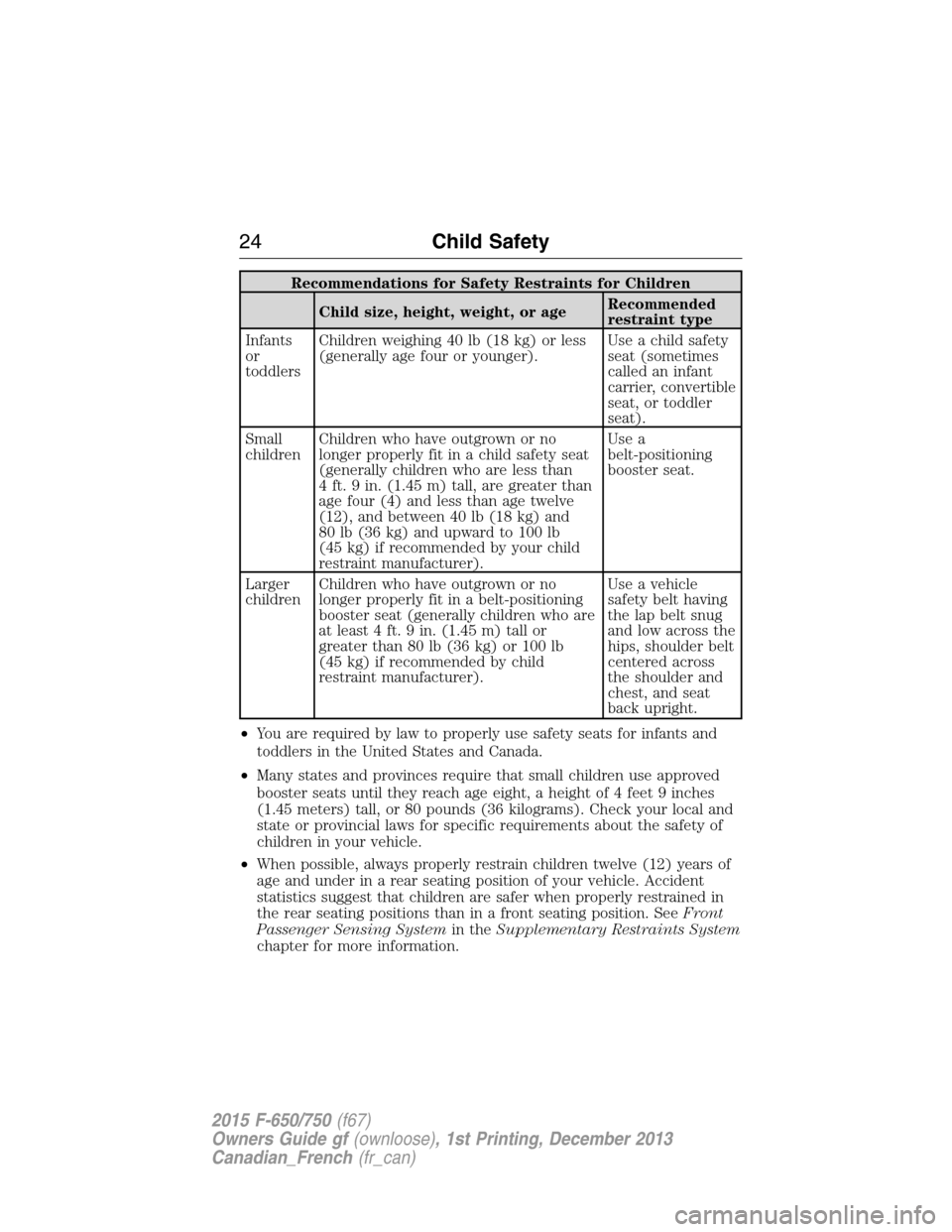
Recommendations for Safety Restraints for Children
Child size, height, weight, or ageRecommended
restraint type
Infants
or
toddlersChildren weighing 40 lb (18 kg) or less
(generally age four or younger).Use a child safety
seat (sometimes
called an infant
carrier, convertible
seat, or toddler
seat).
Small
childrenChildren who have outgrown or no
longer properly fit in a child safety seat
(generally children who are less than
4 ft. 9 in. (1.45 m) tall, are greater than
age four (4) and less than age twelve
(12), and between 40 lb (18 kg) and
80 lb (36 kg) and upward to 100 lb
(45 kg) if recommended by your child
restraint manufacturer).Use a
belt-positioning
booster seat.
Larger
childrenChildren who have outgrown or no
longer properly fit in a belt-positioning
booster seat (generally children who are
at least 4 ft. 9 in. (1.45 m) tall or
greater than 80 lb (36 kg) or 100 lb
(45 kg) if recommended by child
restraint manufacturer).Use a vehicle
safety belt having
the lap belt snug
and low across the
hips, shoulder belt
centered across
the shoulder and
chest, and seat
back upright.
•You are required by law to properly use safety seats for infants and
toddlers in the United States and Canada.
•Many states and provinces require that small children use approved
booster seats until they reach age eight, a height of 4 feet 9 inches
(1.45 meters) tall, or 80 pounds (36 kilograms). Check your local and
state or provincial laws for specific requirements about the safety of
children in your vehicle.
•When possible, always properly restrain children twelve (12) years of
age and under in a rear seating position of your vehicle. Accident
statistics suggest that children are safer when properly restrained in
the rear seating positions than in a front seating position. SeeFront
Passenger Sensing Systemin theSupplementary Restraints System
chapter for more information.
24Child Safety
2015 F-650/750(f67)
Owners Guide gf(ownloose), 1st Printing, December 2013
Canadian_French(fr_can)
Page 26 of 384
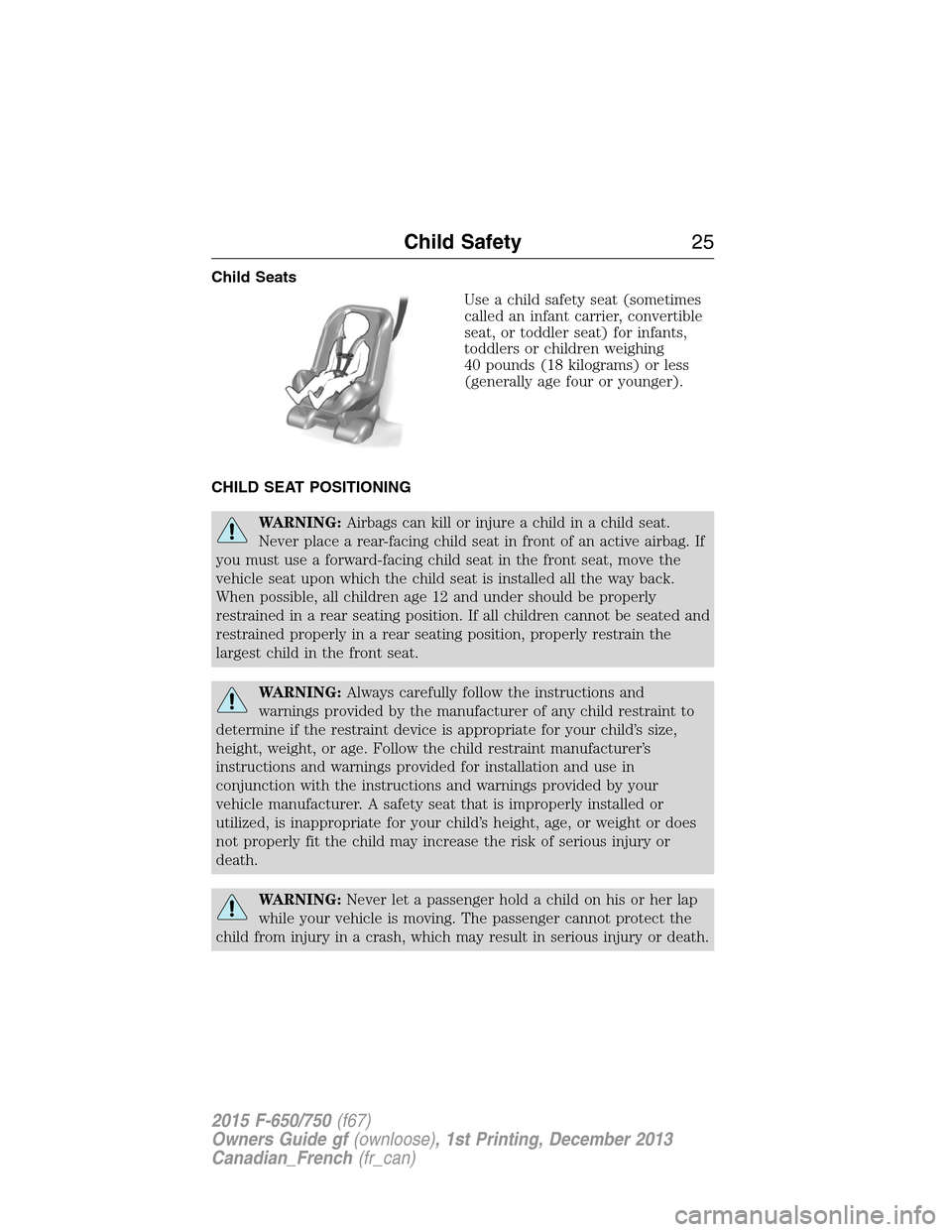
Child Seats
Use a child safety seat (sometimes
called an infant carrier, convertible
seat, or toddler seat) for infants,
toddlers or children weighing
40 pounds (18 kilograms) or less
(generally age four or younger).
CHILD SEAT POSITIONING
WARNING:Airbags can kill or injure a child in a child seat.
Never place a rear-facing child seat in front of an active airbag. If
you must use a forward-facing child seat in the front seat, move the
vehicle seat upon which the child seat is installed all the way back.
When possible, all children age 12 and under should be properly
restrained in a rear seating position. If all children cannot be seated and
restrained properly in a rear seating position, properly restrain the
largest child in the front seat.
WARNING:Always carefully follow the instructions and
warnings provided by the manufacturer of any child restraint to
determine if the restraint device is appropriate for your child’s size,
height, weight, or age. Follow the child restraint manufacturer’s
instructions and warnings provided for installation and use in
conjunction with the instructions and warnings provided by your
vehicle manufacturer. A safety seat that is improperly installed or
utilized, is inappropriate for your child’s height, age, or weight or does
not properly fit the child may increase the risk of serious injury or
death.
WARNING:Never let a passenger hold a child on his or her lap
while your vehicle is moving. The passenger cannot protect the
child from injury in a crash, which may result in serious injury or death.
Child Safety25
2015 F-650/750(f67)
Owners Guide gf(ownloose), 1st Printing, December 2013
Canadian_French(fr_can)
Page 27 of 384

WARNING:Never use pillows, books, or towels to boost a child.
They can slide around and increase the likelihood of injury or
death in a crash.
WARNING:Always restrain an unoccupied child seat or booster
seat. These objects may become projectiles in a crash or sudden
stop, which may increase the risk of serious injury.
WARNING:Never place, or allow a child to place, the shoulder
belt under a child’s arm or behind the back because it reduces
the protection for the upper part of the body and may increase the risk
of injury or death in a crash.
WARNING:To avoid risk of injury, do not leave children or pets
unattended in your vehicle.
Restraint
typeCom-
bined
child
and seat
weightUse any attachment method as indicated
below by “X”
LATCH
(lower
anchors
and top
tether
anchor)LATCH
(lower
anchors
only)Safety
belt
and
top
tether
anchorSafety
belt and
LATCH
(lower
anchors
and top
tether
anchor)Safety
belt
only
Rear fac-
ing child
seatUp to
65 lb
(29 kg)X
Rear fac-
ing child
seatOver
65 lb
(29 kg)X
Forward
facing
child seatUp to
65 lb
(29 kg)X
Forward
facing
child seatOver
65 lb
(29 kg)X
26Child Safety
2015 F-650/750(f67)
Owners Guide gf(ownloose), 1st Printing, December 2013
Canadian_French(fr_can)
Page 28 of 384

Note:The child seat must rest tightly against the vehicle seat upon
which it is installed. It may be necessary to lift or remove the head
restraint. See theSeatschapter for information on head restraints.
BOOSTER SEATS
WARNING:Never place, or allow a child to place, the shoulder
belt under a child’s arm or behind the back because it reduces
the protection for the upper part of the body and may increase the risk
of injury or death in a crash.
Use a belt-positioning booster seat for children who have outgrown or no
longer properly fit in a child safety seat (generally children who are less
than 4 feet 9 inches (1.45 meters) tall, are greater than age four (4) and
less than age twelve (12), and between 40 pounds (18 kilograms) and
80 pounds (36 kilograms) and upward to 100 pounds (45 kilograms) if
recommended by your child restraint manufacturer). Many state and
provincial laws require that children use approved booster seats until
they reach age eight (8), a height of 4 feet 9 inches (1.45 meters) tall, or
80 pounds (36 kilograms).
Booster seats should be used until you can answer YES to ALL of these
questions when the child is seated without a booster seat.
•Can the child sit all the way
back against their vehicle seat
with knees bent comfortably at
the edge of the seat cushion?
•Can the child sit without
slouching?
•Does the lap belt rest low across the hips?
•Is the shoulder belt centered on the shoulder and chest?
•Can the child stay seated like this for the whole trip?
Always use booster seats in conjunction with your vehicle lap and
shoulder belt.
Child Safety27
2015 F-650/750(f67)
Owners Guide gf(ownloose), 1st Printing, December 2013
Canadian_French(fr_can)
Page 29 of 384

Types of Booster Seats
•Backless booster seats
If your backless booster seat has a removable shield, remove the shield.
If a vehicle seating position has a low seat back or no head restraint, a
backless booster seat may place your child’s head (as measured at the
tops of the ears) above the top of the seat. In this case, move the
backless booster to another seating position with a higher seat back or
head restraint and lap and shoulder belts, or consider using a high back
booster seat.
•High back booster seats
If, with a backless booster seat, you cannot find a seating position that
adequately supports your child’s head, a high back booster seat would be
a better choice.
28Child Safety
2015 F-650/750(f67)
Owners Guide gf(ownloose), 1st Printing, December 2013
Canadian_French(fr_can)
Page 30 of 384
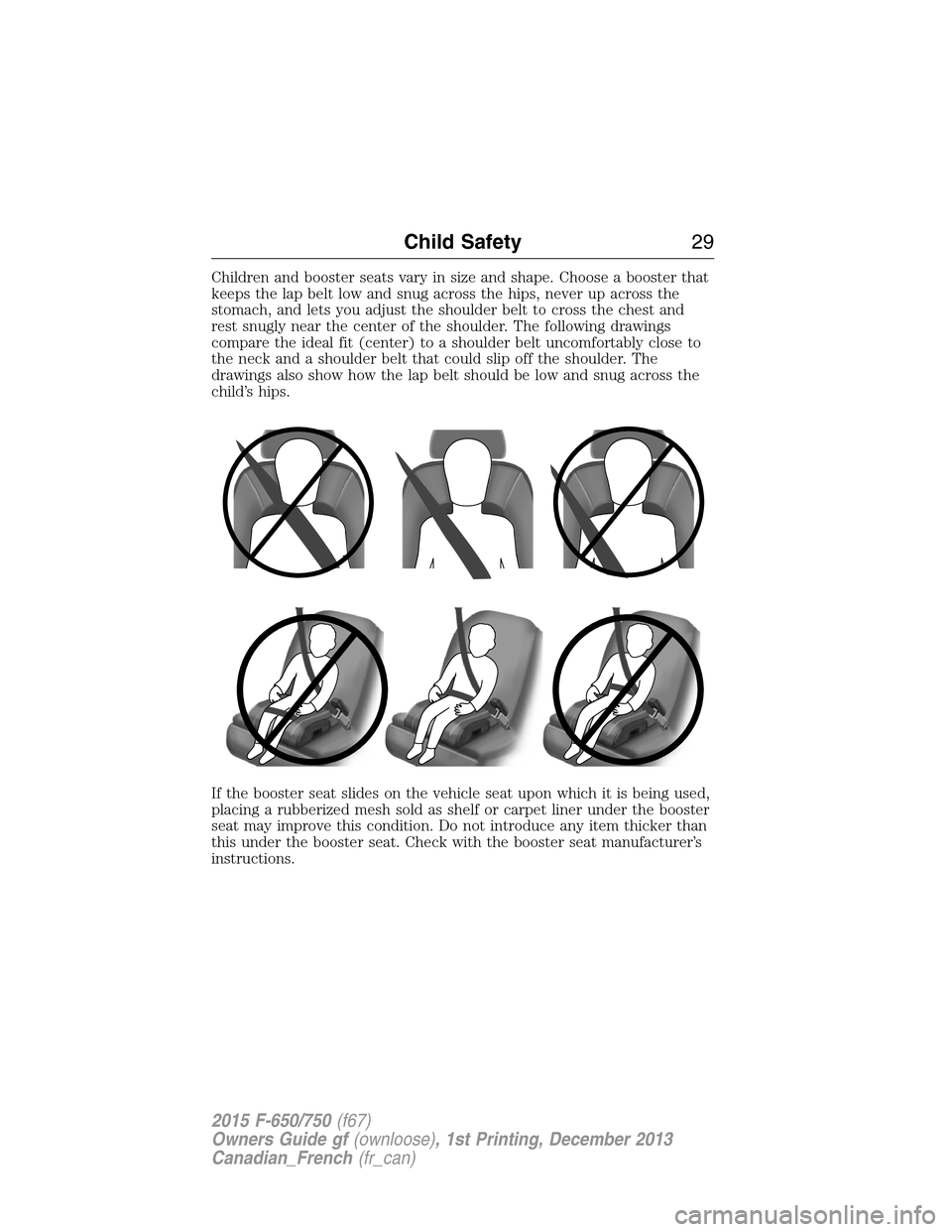
Children and booster seats vary in size and shape. Choose a booster that
keeps the lap belt low and snug across the hips, never up across the
stomach, and lets you adjust the shoulder belt to cross the chest and
rest snugly near the center of the shoulder. The following drawings
compare the ideal fit (center) to a shoulder belt uncomfortably close to
the neck and a shoulder belt that could slip off the shoulder. The
drawings also show how the lap belt should be low and snug across the
child’s hips.
If the booster seat slides on the vehicle seat upon which it is being used,
placing a rubberized mesh sold as shelf or carpet liner under the booster
seat may improve this condition. Do not introduce any item thicker than
this under the booster seat. Check with the booster seat manufacturer’s
instructions.
Child Safety29
2015 F-650/750(f67)
Owners Guide gf(ownloose), 1st Printing, December 2013
Canadian_French(fr_can)